Abstract
Ten patients with severe primary pulmonary hypertension and pronounced disability who were unresponsive to oral vasodilators were treated with intravenous epoprostenol (prostacyclin). All had been referred for heart and lung transplantation. Short term administration of epoprostenol (mean dose 5.5 ng/kg/min) increased the mean cardiac index from 1.8 to 2.2 1/min/m2, improved pulmonary artery oxygen saturation from 48% to 57%, and increased calculated tissue oxygen delivery from 10 to 11.8 ml/kg/min. The mean pulmonary vascular resistance fell by 18% while mean systemic artery pressure fell by 32%. Pulmonary artery pressure rose in only two patients. Continued intravenous infusion of epoprostenol for 1-25 months was associated with subjective and clinical improvement. Exercise tolerance improved as measured by an increase in the maximum rate of oxygen consumption during progressive exercise testing. In those six patients who were able to exercise before treatment it rose from a mean of 7 to 15 ml/kg/min. Those who had been unable to exercise before treatment achieved comparable rates of oxygen consumption after treatment. Two patients died on treatment, three have undergone heart-lung transplantation, and in five the treatment is continuing. Complications included episodes of septicaemia and ascites. In this uncontrolled study of patients with severe pulmonary hypertension epoprostenol seemed to offer a means of optimally dosing the patients with a vasodilator to reduce pulmonary vascular resistance and thus increasing cardiac output and oxygen tissue delivery. There was no evidence to suggest that this treatment influenced the progress of the disease.
Full text
PDF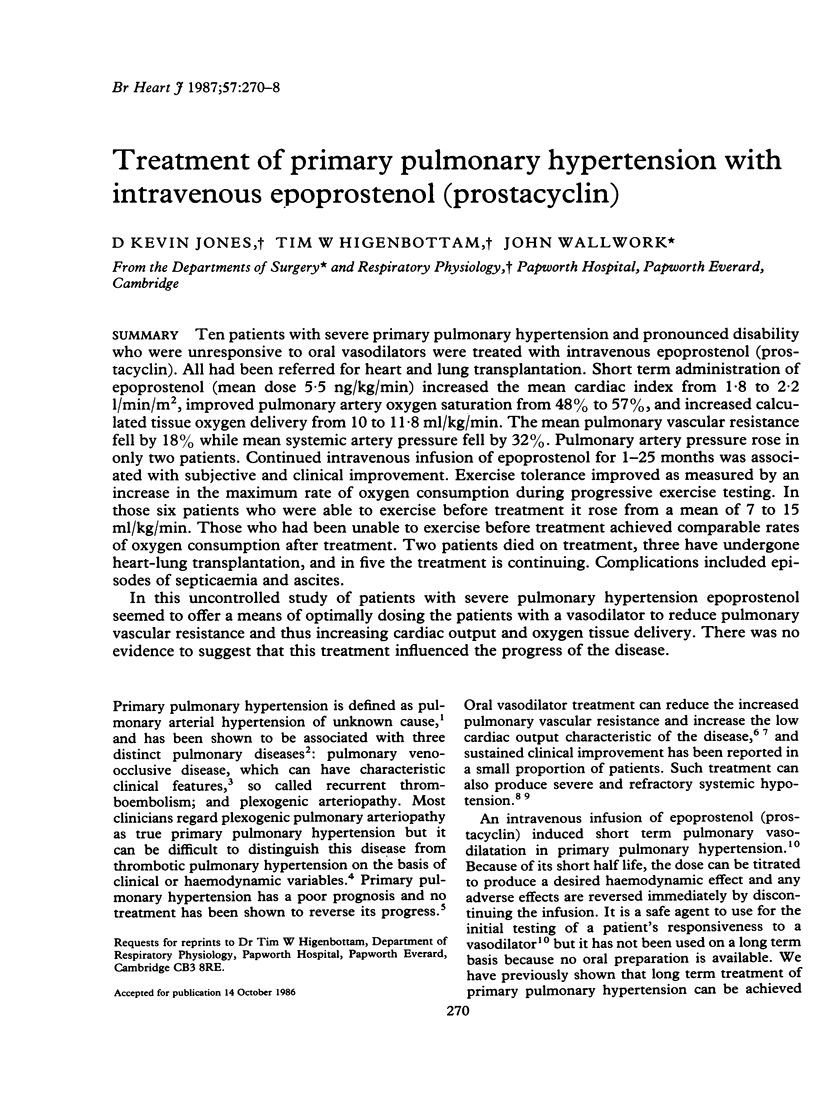
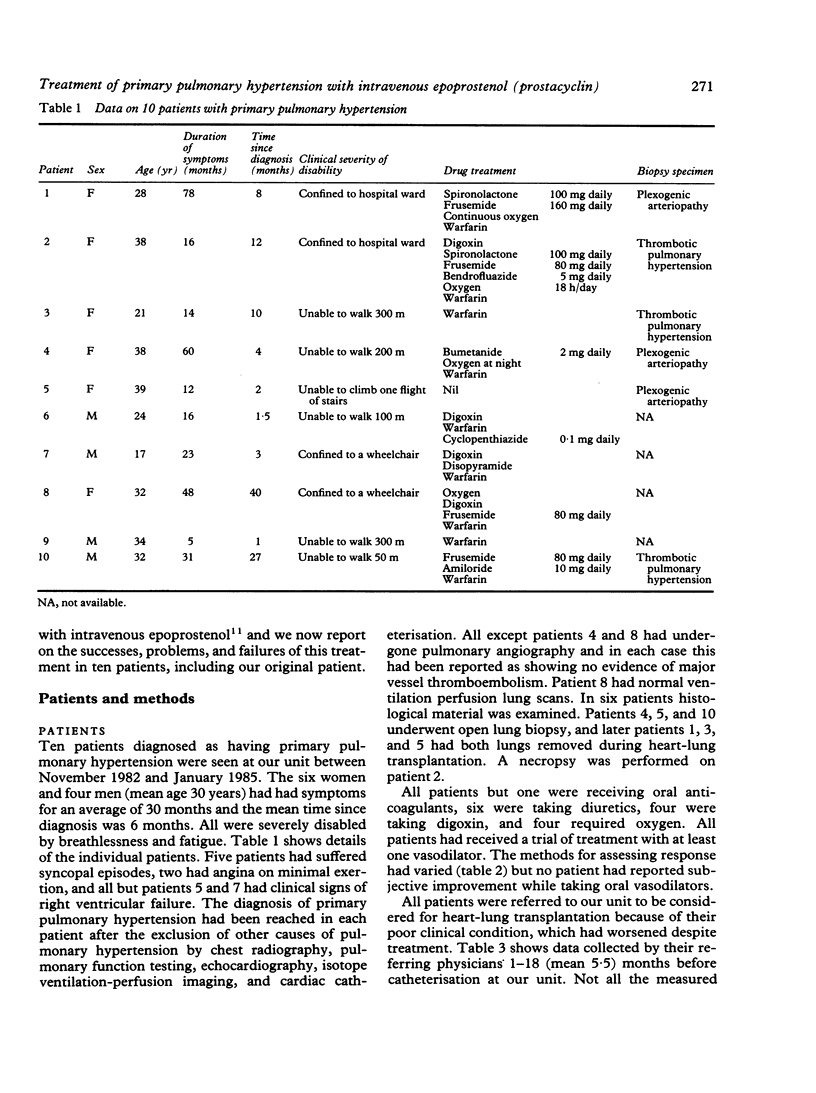
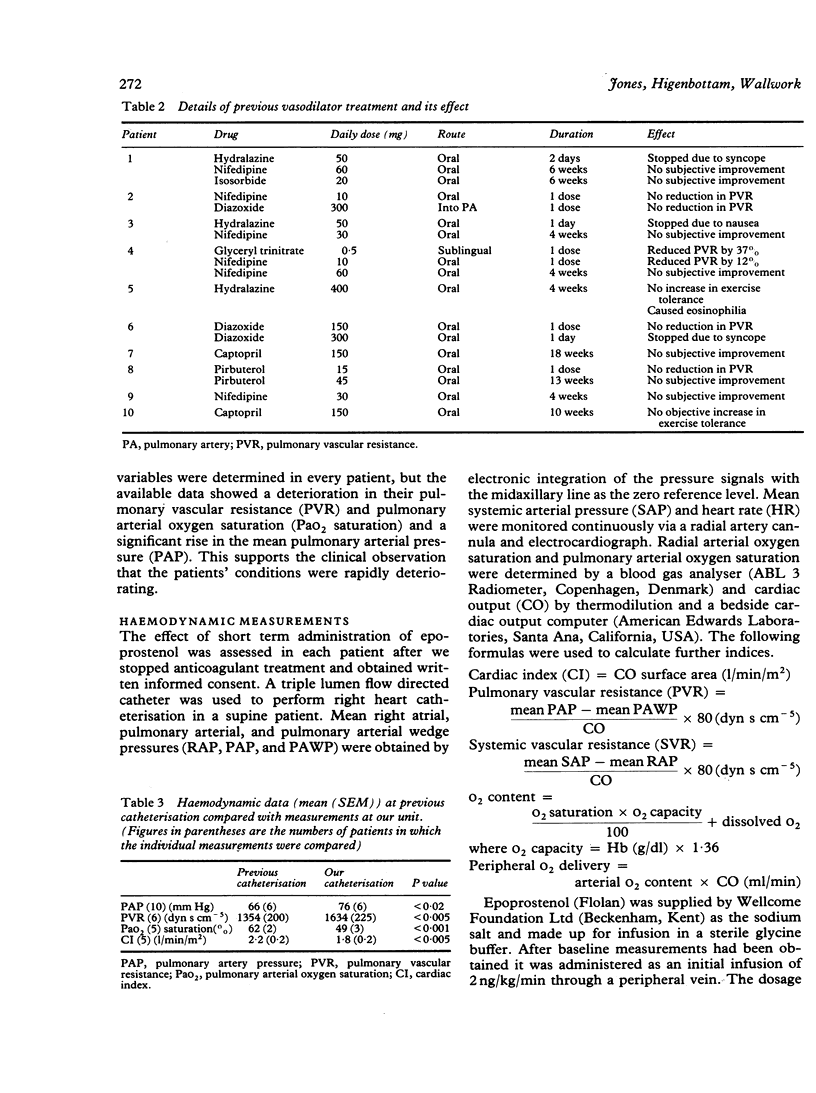
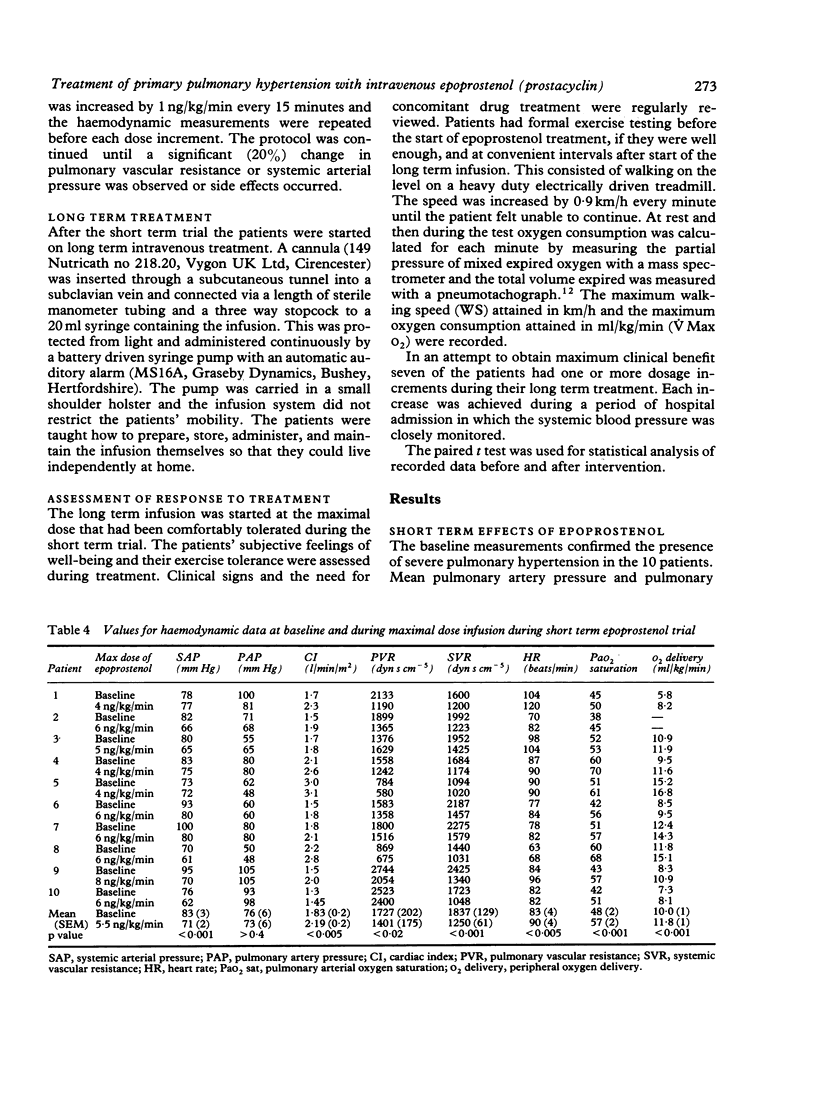
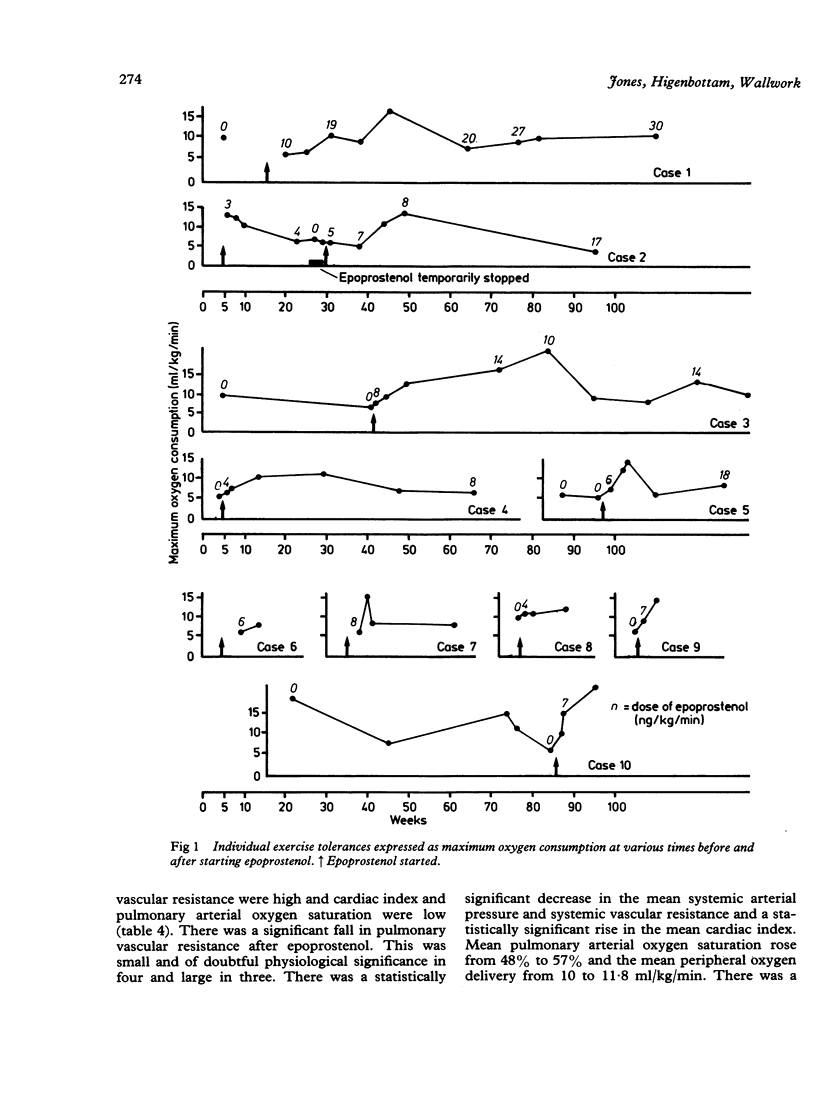
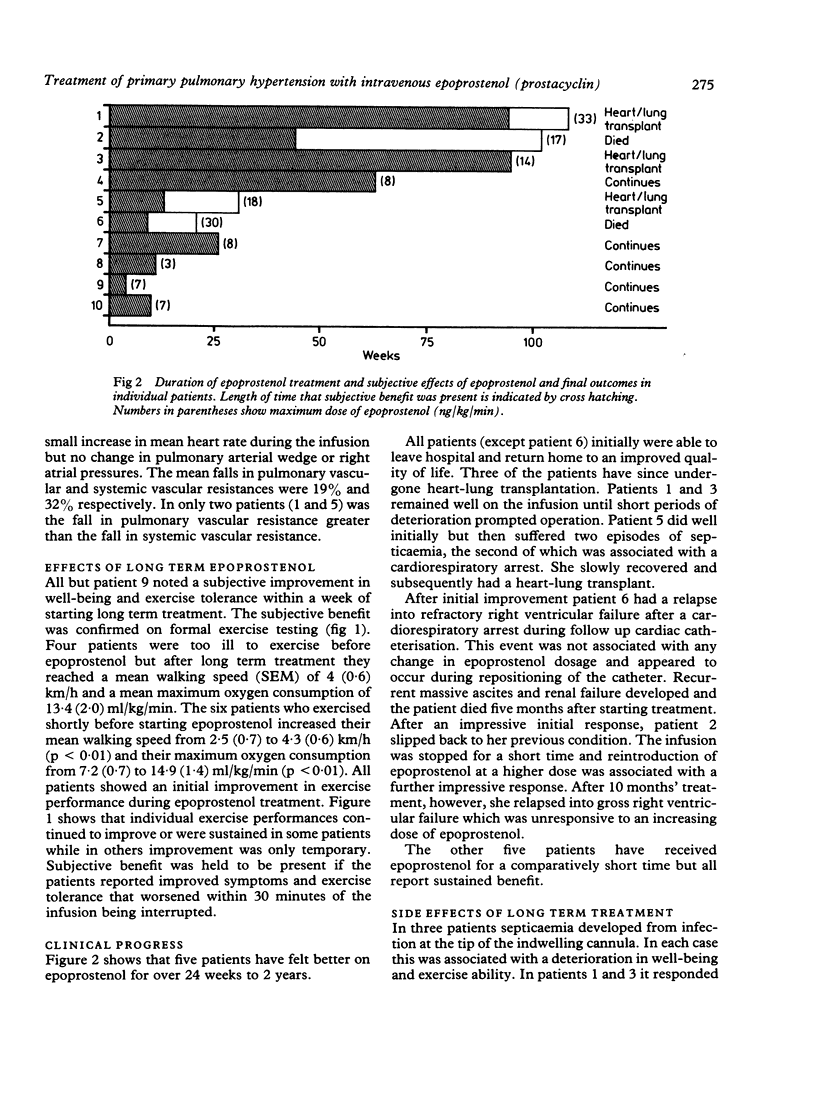
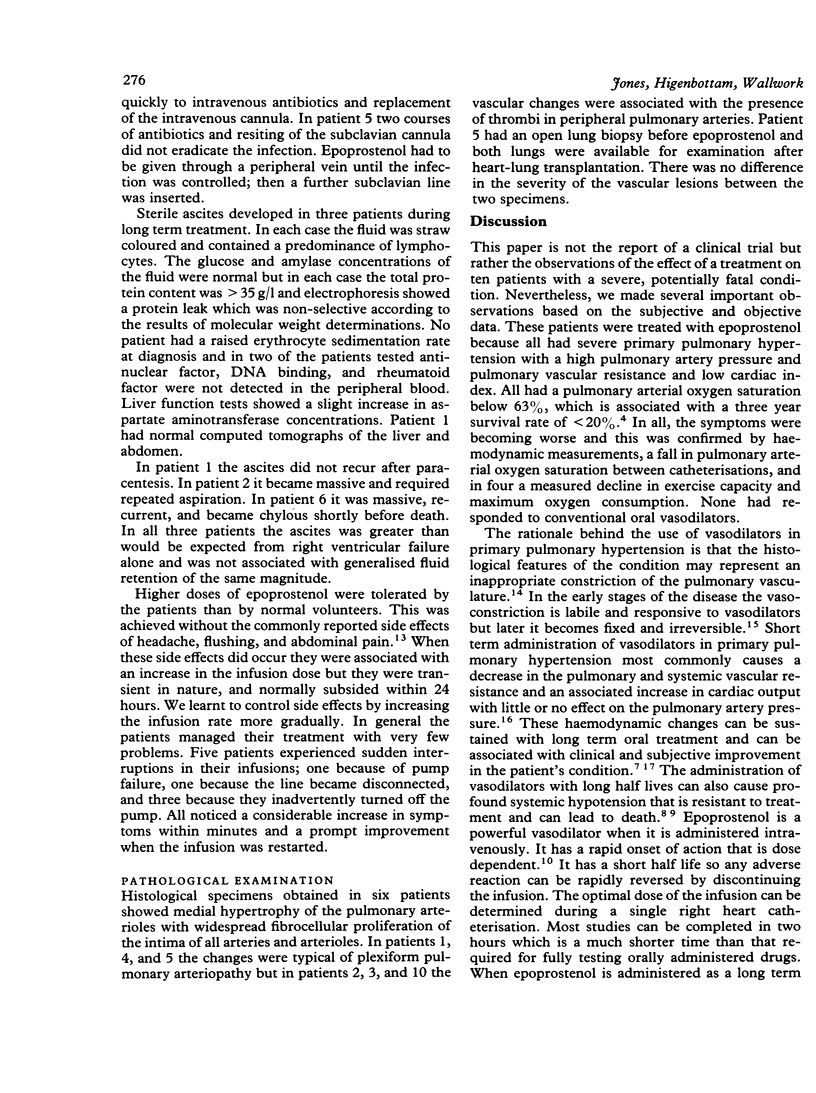
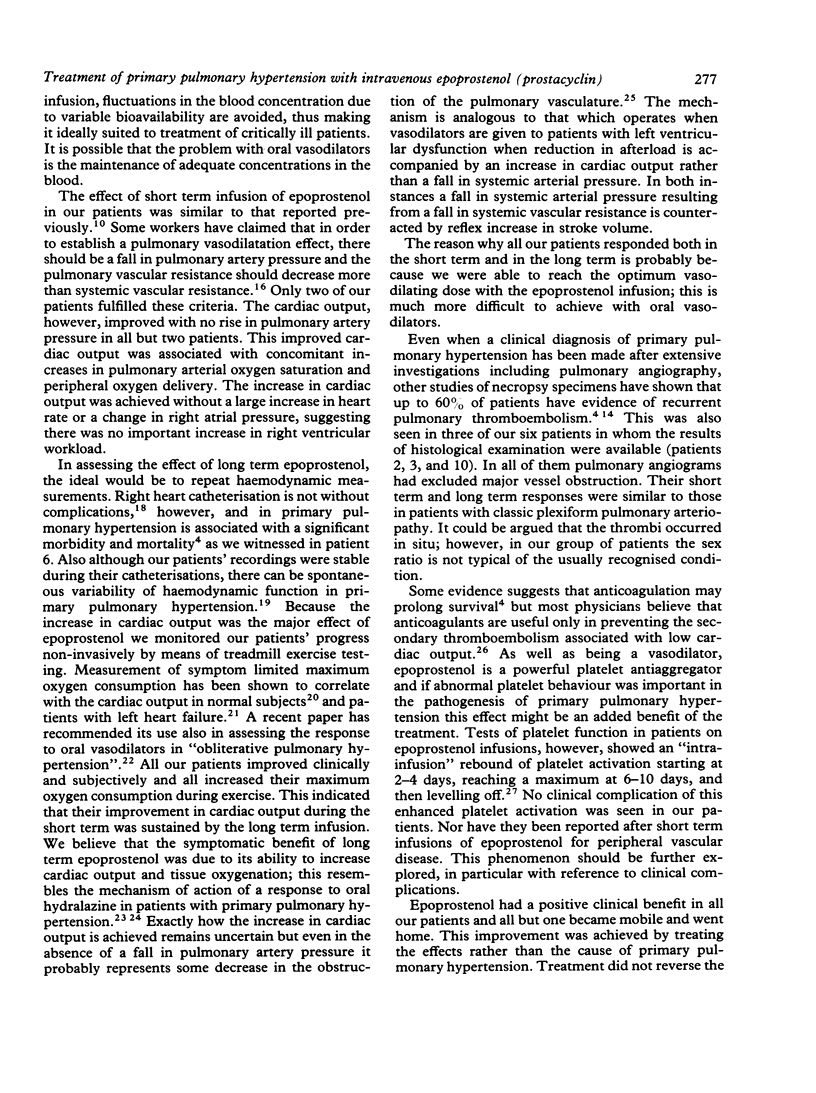
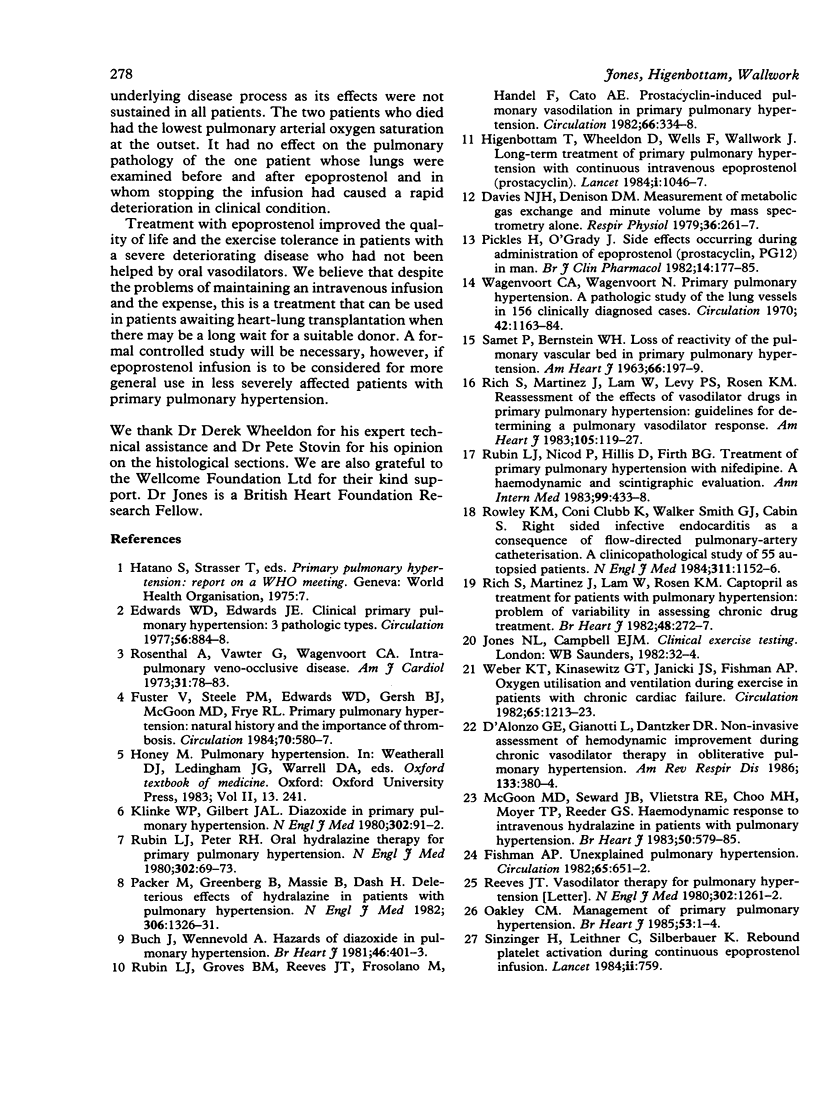
Selected References
These references are in PubMed. This may not be the complete list of references from this article.
- Buch J., Wennevold A. Hazards of diazoxide in pulmonary hypertension. Br Heart J. 1981 Oct;46(4):401–403. doi: 10.1136/hrt.46.4.401. [DOI] [PMC free article] [PubMed] [Google Scholar]
- D'Alonzo G. E., Gianotti L., Dantzker D. R. Noninvasive assessment of hemodynamic improvement during chronic vasodilator therapy in obliterative pulmonary hypertension. Am Rev Respir Dis. 1986 Mar;133(3):380–384. doi: 10.1164/arrd.1986.133.3.380. [DOI] [PubMed] [Google Scholar]
- Davies N. J., Denison D. M. The measurement of metabolic gas exchange and minute volume by mass spectrometry alone. Respir Physiol. 1979 Feb;36(2):261–267. doi: 10.1016/0034-5687(79)90029-x. [DOI] [PubMed] [Google Scholar]
- Edwards W. D., Edwards J. E. Clinical primary pulmonary hypertension: three pathologic types. Circulation. 1977 Nov;56(5):884–888. doi: 10.1161/01.cir.56.5.884. [DOI] [PubMed] [Google Scholar]
- Fishman A. P. Unexplained pulmonary hypertension. Circulation. 1982 Apr;65(4):651–652. doi: 10.1161/01.cir.65.4.651. [DOI] [PubMed] [Google Scholar]
- Fuster V., Steele P. M., Edwards W. D., Gersh B. J., McGoon M. D., Frye R. L. Primary pulmonary hypertension: natural history and the importance of thrombosis. Circulation. 1984 Oct;70(4):580–587. doi: 10.1161/01.cir.70.4.580. [DOI] [PubMed] [Google Scholar]
- Higenbottam T., Wheeldon D., Wells F., Wallwork J. Long-term treatment of primary pulmonary hypertension with continuous intravenous epoprostenol (prostacyclin). Lancet. 1984 May 12;1(8385):1046–1047. doi: 10.1016/s0140-6736(84)91452-1. [DOI] [PubMed] [Google Scholar]
- Klinke W. P., Gilbert J. A. Diazoxide in primary pulmonary hypertension. N Engl J Med. 1980 Jan 10;302(2):91–92. doi: 10.1056/NEJM198001103020204. [DOI] [PubMed] [Google Scholar]
- McGoon M. D., Seward J. B., Vlietstra R. E., Choo M. H., Moyer T. P., Reeder G. S. Haemodynamic response to intravenous hydralazine in patients with pulmonary hypertension. Br Heart J. 1983 Dec;50(6):579–585. doi: 10.1136/hrt.50.6.579. [DOI] [PMC free article] [PubMed] [Google Scholar]
- Oakley C. M. Management of primary pulmonary hypertension. Br Heart J. 1985 Jan;53(1):1–4. doi: 10.1136/hrt.53.1.1. [DOI] [PMC free article] [PubMed] [Google Scholar]
- Olukotun A. Y. Vasodilator therapy for pulmonary hypertension. N Engl J Med. 1980 May 29;302(22):1261–1262. [PubMed] [Google Scholar]
- Packer M., Greenberg B., Massie B., Dash H. Deleterious effects of hydralazine in patients with pulmonary hypertension. N Engl J Med. 1982 Jun 3;306(22):1326–1331. doi: 10.1056/NEJM198206033062203. [DOI] [PubMed] [Google Scholar]
- Pickles H., O'Grady J. Side effects occurring during administration of epoprostenol (prostacyclin, PGI2), in man. Br J Clin Pharmacol. 1982 Aug;14(2):177–185. doi: 10.1111/j.1365-2125.1982.tb01959.x. [DOI] [PMC free article] [PubMed] [Google Scholar]
- Rich S., Martinez J., Lam W., Levy P. S., Rosen K. M. Reassessment of the effects of vasodilator drugs in primary pulmonary hypertension: guidelines for determining a pulmonary vasodilator response. Am Heart J. 1983 Jan;105(1):119–127. doi: 10.1016/0002-8703(83)90288-0. [DOI] [PubMed] [Google Scholar]
- Rich S., Martinez J., Lam W., Rosen K. M. Captopril as treatment for patients with pulmonary hypertension. Problem of variability in assessing chronic drug treatment. Br Heart J. 1982 Sep;48(3):272–277. doi: 10.1136/hrt.48.3.272. [DOI] [PMC free article] [PubMed] [Google Scholar]
- Rosenthal A., Vawter G., Wagenvoort C. A. Intrapulmonary veno-occlusive disease. Am J Cardiol. 1973 Jan;31(1):78–83. doi: 10.1016/0002-9149(73)90814-x. [DOI] [PubMed] [Google Scholar]
- Rowley K. M., Clubb K. S., Smith G. J., Cabin H. S. Right-sided infective endocarditis as a consequence of flow-directed pulmonary-artery catheterization. A clinicopathological study of 55 autopsied patients. N Engl J Med. 1984 Nov 1;311(18):1152–1156. doi: 10.1056/NEJM198411013111804. [DOI] [PubMed] [Google Scholar]
- Rubin L. J., Groves B. M., Reeves J. T., Frosolono M., Handel F., Cato A. E. Prostacyclin-induced acute pulmonary vasodilation in primary pulmonary hypertension. Circulation. 1982 Aug;66(2):334–338. doi: 10.1161/01.cir.66.2.334. [DOI] [PubMed] [Google Scholar]
- Rubin L. J., Nicod P., Hillis L. D., Firth B. G. Treatment of primary pulmonary hypertension with nifedipine. A hemodynamic and scintigraphic evaluation. Ann Intern Med. 1983 Oct;99(4):433–438. doi: 10.7326/0003-4819-99-4-433. [DOI] [PubMed] [Google Scholar]
- Rubin L. J., Peter R. H. Oral hydralazine therapy for primary pulmonary hypertension. N Engl J Med. 1980 Jan 10;302(2):69–73. doi: 10.1056/NEJM198001103020201. [DOI] [PubMed] [Google Scholar]
- SAMET P., BERNSTEIN W. H. LOSS OF REACTIVITY OF THE PULMONARY VASCULAR BED IN PRIMARY PULMONARY HYPERTENSION. Am Heart J. 1963 Aug;66:197–199. doi: 10.1016/0002-8703(63)90034-6. [DOI] [PubMed] [Google Scholar]
- Sinzinger H., Leithner C., Silberbauer K. Rebound platelet activation during continuous epoprostenol infusion. Lancet. 1984 Sep 29;2(8405):759–759. doi: 10.1016/s0140-6736(84)92672-2. [DOI] [PubMed] [Google Scholar]
- Weber K. T., Kinasewitz G. T., Janicki J. S., Fishman A. P. Oxygen utilization and ventilation during exercise in patients with chronic cardiac failure. Circulation. 1982 Jun;65(6):1213–1223. doi: 10.1161/01.cir.65.6.1213. [DOI] [PubMed] [Google Scholar]


